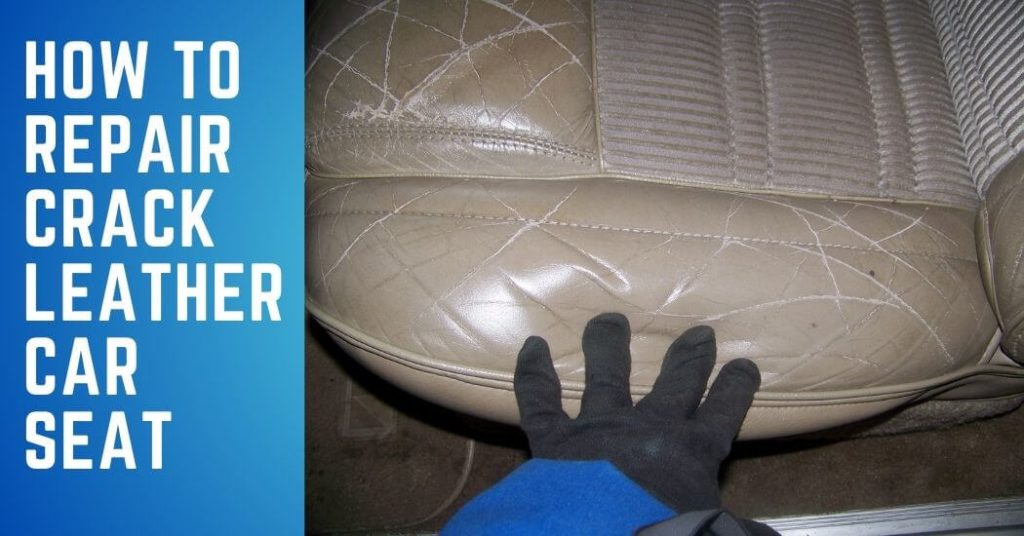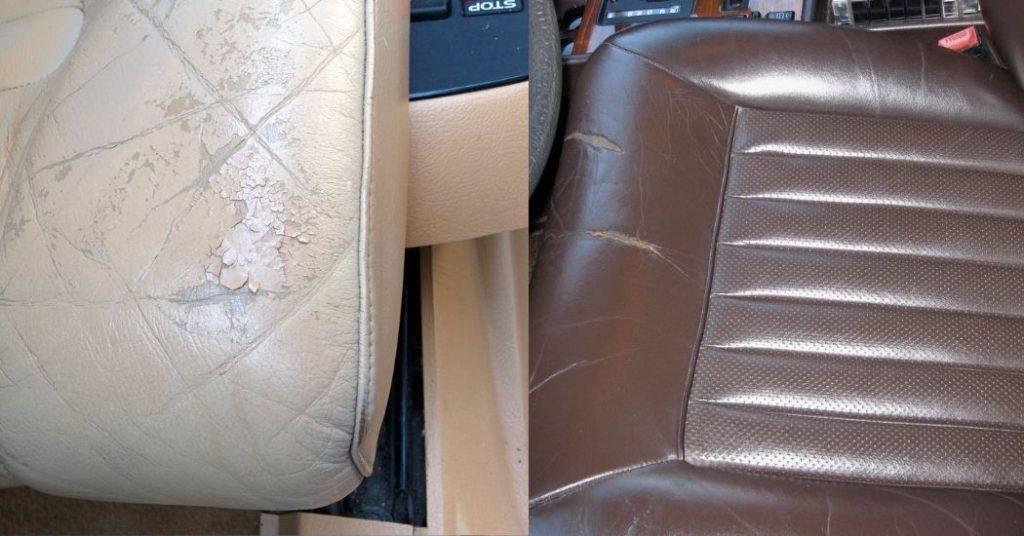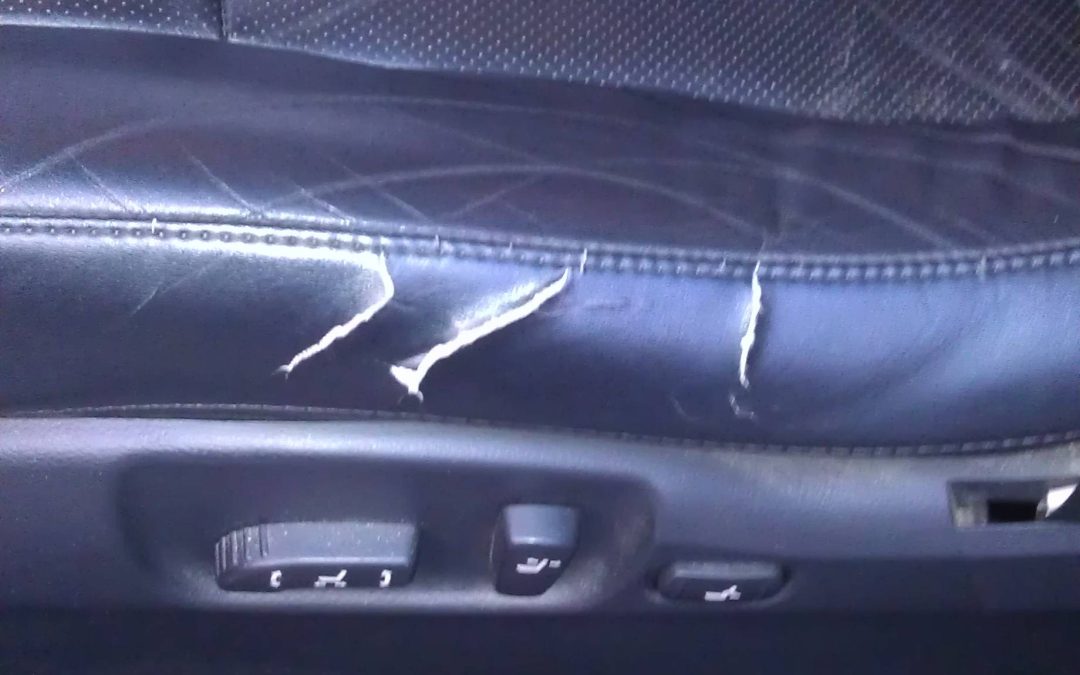This article was updated in July 24, 2023 with new products and information by Mark S. Taylor
To repair a crack in a leather car seat, clean the area, apply a leather filler, and gently sand it down for a smooth finish. Leather repair kits are widely available and provide the necessary materials and instructions for this process.
Cracked leather car seats not only detract from the overall appearance of your vehicle but can also worsen if left unattended. By following these simple steps, you can restore the cracked area, prolonging the lifespan of your car seats and enhancing the overall aesthetic of your car’s interior.
It is important to address the crack as soon as possible to prevent further damage and maintain the value of your vehicle.

Contents
Why Is It Important To Repair Cracked Leather Car Seat?
Cracked leather car seats not only diminish the overall look of your vehicle but also have a negative impact on its value and comfort. Repairing these cracks is crucial to maintain the aesthetic appeal and ensure the durability and longevity of your car’s interior.
In this section, we will explore why it is important to repair cracked leather car seats, emphasizing how it enhances the aesthetic appeal, preserves the value, and ensures comfort and durability.
Enhancing The Aesthetic Appeal Of The Car
Repairing cracked leather car seats is essential for enhancing the overall aesthetic appeal of your vehicle. Here are the key points to consider:
- Cracks in leather seats can be an eyesore and detract from the visual appeal of your car’s interior.
- Restoring the smooth and pristine appearance of the leather seats can make your car look cleaner, newer, and more appealing.
- A well-maintained leather interior creates a positive impression and adds a touch of luxury and sophistication to your car.
- By repairing the cracks, you can retain the original beauty of the leather, making your car’s interior more inviting and enjoyable.
Preserving The Value Of The Vehicle
Repairing cracked leather car seats is not just about aesthetics; it also plays a vital role in preserving the value of your vehicle. Here’s why:
- Cracked and damaged leather seats can significantly reduce the resale value of your car.
- Prospective buyers may perceive a poorly maintained interior as a sign of neglect and potential issues with the rest of the vehicle.
- Repairing the cracks allows you to maintain the overall condition of your car and maximize its value when it’s time to sell or trade it in.
- Well-maintained leather seats can contribute to a higher resale price and attract more potential buyers.
Ensuring Comfort And Durability
Beyond appearances and value, repairing cracked leather car seats also ensures comfort and durability for you and your passengers. Consider the following points:
- Cracked seats can cause discomfort during long drives, as the cracks may dig into your skin or pinch you.
- By repairing the cracks, you can restore the smoothness and flexibility of the leather, providing a more comfortable seating experience.
- Repairing the cracks also prevents further damage and deterioration of the leather, ensuring its durability over time.
- Well-preserved leather seats are less likely to develop additional cracks or tears, prolonging their lifespan and reducing the need for frequent repairs.
Maintaining value and comfort: repairing cracked leather car seats is essential for enhancing the aesthetic appeal of your vehicle, preserving its value, and ensuring comfort and durability. By taking the necessary steps to repair these cracks, you can enjoy a visually appealing, comfortable, and long-lasting interior that adds value and pleasure to your driving experience.
Assessing The Severity Of The Crack
Cracks in leather car seats can be a real eyesore and can diminish the overall appearance of your vehicle’s interior. If left untreated, they can also worsen over time, leading to more extensive damage. But before you jump into repairing the cracks, it’s important to assess the severity of the damage to determine the appropriate course of action.
In this section, we will guide you through the process of evaluating the severity of the cracks in your leather car seat.
Identifying Types Of Cracks (Surface-Level Or Deep):
When it comes to leather car seat cracks, it’s crucial to identify the depth of the damage. This will help you determine the most suitable repair method. Here are the key points to consider:
- Surface-level cracks: These are superficial cracks that only affect the top layer of the leather. They are usually caused by normal wear and tear, exposure to sunlight, or dryness. Surface-level cracks are relatively easier to repair and can often be fixed with diy methods or leather repair kits.
- Deep cracks: Deep cracks penetrate deeper into the leather, affecting the underlying layers. These cracks are often a result of prolonged neglect, heavy use, or accidents. Repairing deep cracks may require professional expertise and specialized techniques to restore the integrity of the leather.
Determining If The Crack Is Repairable:
Once you have identified the type of crack, the next step is to assess whether it is repairable or if it requires replacement. Consider the following factors:
- Size of the crack: Small cracks can usually be repaired effectively, while larger cracks may necessitate replacement. Measure the width and length of the crack to determine its size.
- Extent of damage: Assess the overall condition of the leather surrounding the crack. If the leather is severely worn, faded, or brittle, it may be more practical to opt for a replacement rather than a repair.
- Budget and time constraints: Consider your budget and the time you’re willing to invest in the repair process. Repairing cracks can be time-consuming, especially if they are deep or extensive. Replacement, on the other hand, may provide a quicker solution if you’re in a hurry.
By evaluating the severity of the cracks in your leather car seat, you can make an informed decision about the best course of action for repair or replacement. Remember, addressing the issue early on can help prevent further damage and extend the lifespan of your car’s interior.

Diy Methods To Repair Crack Leather Car Seat
Leather car seats add a touch of luxury and sophistication to any vehicle, but over time, they can develop cracks and become worn out. If you want to give your car seats a new lease on life without breaking the bank, diy leather car seat repair is a great option.
In this section, we will discuss three effective methods to repair crack leather car seats. So, let’s dive in and learn how to bring back the charm to your car seats!
Clean The Leather Surface
Before getting started with the repair process, it’s crucial to thoroughly clean the leather surface to ensure proper adhesion of the repair materials. Start by using a mild leather cleaner and a soft cloth to remove any dirt, grime, or oils from the seat.
Follow these steps for a thorough cleanup:
- Apply a small amount of leather cleaner to the cloth and gently wipe the surface.
- Work your way across the entire seat, paying attention to the cracks and crevices.
- Use a soft-bristled brush to remove any stubborn dirt.
- Once clean, wipe down the seat with a dry cloth to remove any excess moisture.
Applying A Leather Filler
After the cleaning process, it’s time to apply a leather filler to the cracks in the car seat. A leather filler helps fill in the gaps and restore the smoothness of the surface. Here’s how you can do it:
- Choose a high-quality leather filler that matches the color of your car seat.
- Apply a small amount of filler to a palette knife or a thin plastic spatula.
- Gently and evenly spread the filler over the cracked areas, making sure to fill in the gaps completely.
- Smooth out the excess filler with the palette knife, creating a seamless finish.
- Allow the filler to dry completely, following the manufacturer’s instructions.
Sanding And Smoothing The Area
Once the leather filler is dry, it’s time to sand and smooth the repaired area for a flawless finish. Here’s what you need to do:
- Use fine-grit sandpaper to lightly sand the filled cracks, taking care not to damage the surrounding leather.
- Sand in gentle circular motions until the surface is even and smooth.
- Wipe away any dust using a clean, damp cloth.
- Apply a leather conditioner or a protector to restore the seat’s natural shine and protect it from future damage.
By following these diy methods, you can effectively repair crack leather car seats and bring back their original beauty. Remember to take your time and be patient throughout the repair process for the best results. With a little effort and the right techniques, your car seats will look as good as new!
Professional Options For Repairing Cracked Leather Car Seat
Cracked leather car seats can be a real eyesore and diminish the overall appeal of your vehicle’s interior. While there are diy methods to try and fix the problem, sometimes it’s best to turn to professionals for expert assistance.
Here are some key reasons to consider professional leather car seat repair and tips for choosing a reputable specialist.
Reasons To Consider Professional Assistance:
- Extensive knowledge and experience: Professional leather repair specialists have the expertise to assess the extent of the damage and determine the most suitable repair techniques. They are trained in handling various types of leather and have the necessary tools to effectively fix cracks without causing further damage.
- Quality results: Opting for professional repairs ensures that the outcome will be of the highest quality. These experts have access to advanced techniques and products specifically designed for leather repair. They can seamlessly restore your cracked leather car seat, making it look as good as new.
- Time-saving: Repairing cracked leather seats can be a time-consuming process, especially if you don’t have the necessary skills and tools. By hiring a professional, you can save yourself valuable time and effort while still achieving great results.
Choosing A Reputable Leather Repair Specialist:
- Research and read reviews: Start by conducting thorough research to find reputable leather repair specialists in your area. Read customer reviews and testimonials to get an idea of their reputation and the quality of their work.
- Ask for referrals: Seek recommendations from friends, family, or colleagues who have had their leather car seats repaired in the past. Their personal experiences can help you make an informed decision when choosing a specialist.
- Check credentials and experience: Ensure that the professional you choose is properly licensed and certified. Look for specialists who have extensive experience in leather car seat repair, as this indicates their expertise and reliability.
- Request a consultation and estimate: Before making a final decision, schedule a consultation with a few specialists to discuss your specific repair needs. This will allow you to get an estimate of the cost and timeline involved, as well as evaluate their communication skills and professionalism.
Restoring With Professional Techniques:
- Thorough cleaning and preparation: The first step in professional leather car seat repair is to thoroughly clean the seat to remove any dirt, grime, or old product residues. This ensures that the repair process can be carried out on a clean surface for optimal results.
- Repairing the cracks: Professional leather repair specialists will use specialized techniques to repair the cracks on your car seat. They can employ methods such as filling, heat-strengthening, or patching, depending on the severity and location of the cracks.
- Color matching and refinishing: After the cracks have been repaired, the next step is to match the color of the leather and apply suitable refinishing products. This ensures a seamless look and restores the original aesthetic appeal of your car seat.
- Protective coating: To prolong the life of the repaired leather and enhance its durability, professionals apply a protective coating that safeguards against future cracking and damage. This coating also helps in maintaining the leather’s softness and suppleness.
By considering professional assistance, choosing a reputable leather repair specialist, and restoring your cracked leather car seat with professional techniques, you can ensure a high-quality, long-lasting repair that will rejuvenate the interior of your vehicle. Don’t let cracked leather seats bring down the overall value and appearance of your car when there are experts available to help you resolve the issue with precision and expertise.
Preventive Measures For Maintaining Leather Car Seats
Leather car seats add a touch of luxury and sophistication to any vehicle. However, over time, they can develop cracks and damage if not properly maintained. Taking preventive measures to care for your leather car seats is essential to keep them looking and feeling their best.
In this section, we will explore a few key preventive measures for maintaining leather car seats.
Regular Cleaning And Soft Brushing
- Regularly clean your leather car seats using a mild leather cleaner. This will help remove dirt, dust, and oils that can accumulate on the surface.
- Use a soft-bristle brush to gently brush the entire surface of the seat. This will help prevent any dirt or debris from settling into the leather’s pores.
- Avoid using harsh chemicals or abrasive brushes, as they can damage the leather and cause it to crack.
Applying Leather Conditioners And Protectants
- Leather conditioners help to moisturize and nourish the leather, keeping it soft and supple. Apply a small amount of leather conditioner to a clean cloth and gently rub it onto the seats in circular motions.
- Leather protectants act as a barrier against spills, stains, and UV damage. Apply a layer of leather protectant to the seats after cleaning and conditioning them.
- Be sure to follow the manufacturer’s instructions when applying leather conditioners and protectants, as different products may have specific guidelines.
Protecting From Sunlight And Extreme Temperatures
- Direct sunlight can cause leather to fade and crack over time. Park your car in shaded areas or use window shades to protect your leather seats from prolonged exposure to sunlight.
- Extreme temperatures can also damage leather. Avoid parking your car in extremely hot or cold environments whenever possible.
- If your car is parked in the sun for an extended period, consider using a leather seat cover or towel to protect the seats from direct sunlight and heat.
By following these preventive measures, you can enhance the longevity and appearance of your leather car seats. Regular cleaning, conditioning, and protection from sunlight and extreme temperatures are key to maintaining the beauty and durability of your leather seats. Incorporate these practices into your car care routine to ensure that your leather seats stay in top condition for years to come.
Frequently Asked Questions For How To Repair Crack Leather Car Seat
How Can I Repair A Crack In My Leather Car Seat?
To repair a crack in your leather car seat, start by cleaning the seat with a mild leather cleaner. Then, apply a leather repair compound to fill in the crack and smooth it out. Finally, use a leather conditioner to restore moisture and prevent future cracking.
Conclusion
Repairing cracked leather car seats is easier than you may have believed. By following the steps outlined in this blog post, you can save yourself the cost and hassle of replacing your seats entirely. First, identify the extent of the damage and clean the seat properly.
Next, use a leather repair kit to fill in the cracks and restore the surface. Remember to match the color and texture as closely as possible for a seamless appearance. Lastly, condition and protect the leather to prevent future cracking and maintain its overall quality.
By utilizing these simple techniques, you can extend the life of your leather car seats and keep them looking pristine. Don’t let cracked leather diminish the beauty of your vehicle. Take action today and restore your seats to their former glory.

